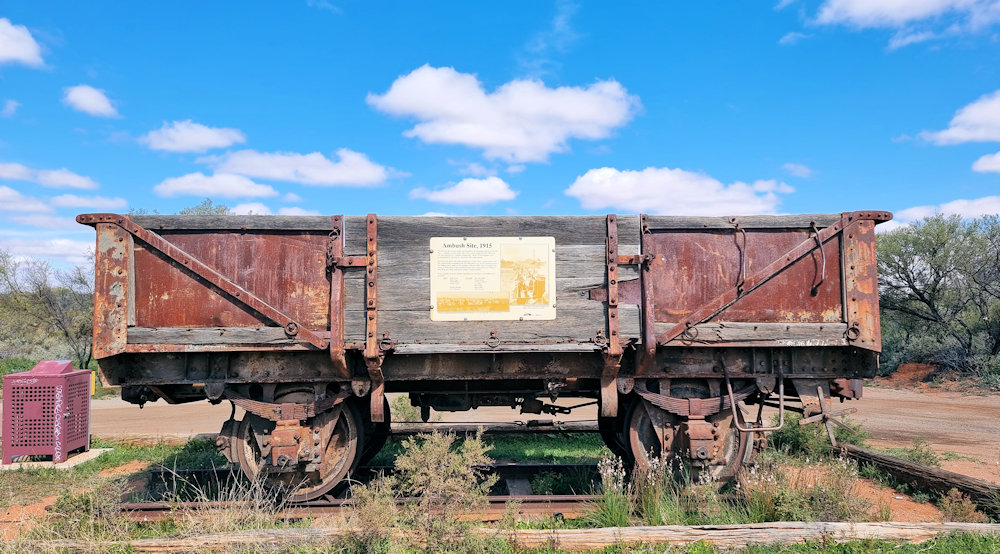The Battle of Broken Hill
On 1 January 1915, the quiet mining town of Broken Hill, New South Wales, experienced one of the most unexpected attacks in Australian history. While many residents celebrated the New Year with a picnic train excursion, two men launched a violent assault that would later be known as the Battle of Broken Hill. The incident shocked the nation and marked one of the earliest wartime attacks on Australian soil.
That morning, a train carrying around 1,200 holidaymakers left Broken Hill for Silverton. Among the passengers were families, workers, and soldiers from the local rifle club. At about 10:10 a.m., as the train passed through the scrub at West Camel Camp, shots rang out from a white ice-cream cart flying a small red Ottoman flag. Within moments, four people lay dead, and several others were seriously wounded.
The Attackers and Their Motives
The attackers were Mullah Abdullah, an Afghan camel driver and local imam, and Gool Mohamed, a former cameleer from the British Indian region of Punjab. Both had lived in Broken Hill for years. However, social tensions and personal grievances had left them alienated. Abdullah had recently been fined for slaughtering sheep without a licence, while Mohamed struggled with poverty and discrimination.
When the First World War began in August 1914, the Ottoman Empire joined the Central Powers against Britain. Consequently, Muslims in the empire were encouraged to wage jihad against the Allies. Abdullah and Mohamed saw themselves as acting under this religious duty. They draped their cart with the Ottoman flag and attacked in its name. Although their action was not directed by any formal organisation, they believed they were defending their faith and homeland.
The Pursuit Through the Desert
After the attack, Abdullah and Mohamed fled into the surrounding hills. Police, soldiers from the local militia, and armed civilians quickly pursued them. The chase unfolded under the harsh summer sun, and word spread rapidly across town. Many locals armed themselves and joined the pursuit, determined to stop further violence.
The gunmen took cover among the rocky outcrops near Cable Hill, trading shots with their pursuers. For more than two hours, bullets echoed across the barren landscape. Eventually, the attackers were cornered. Despite calls for surrender, they refused to lay down their arms. Both men were killed in the final exchange of fire around midday. By then, the toll had risen to six dead, including the attackers, and at least seven wounded.
The Community’s Reaction
The people of Broken Hill were horrified. Until that day, war had seemed distant, confined to Europe and the Middle East. Now it had reached their doorstep. In the following hours, fear and anger spread through the town. Many residents directed their outrage toward the local Afghan and Muslim communities, who had lived peacefully there for decades.
As a result, several Afghan homes and the local mosque were attacked and damaged. Police eventually restored order, but tensions remained high for weeks. Although community leaders condemned the violence, suspicion lingered. The attack deepened divisions and reflected how global conflict could inflame local prejudice.
National Impact and Legacy
News of the Battle of Broken Hill reached the rest of Australia within days. Newspapers across the country carried headlines describing it as an “enemy outrage.” For many Australians, it confirmed the fear that even distant enemies could strike at home. However, others viewed it as an isolated act driven by despair rather than organised terrorism.
The event also influenced wartime attitudes toward migrants, especially those from Middle Eastern or South Asian backgrounds. It strengthened calls for stricter surveillance of “enemy aliens” and shaped early security policies. Yet, over time, historians have reinterpreted the incident not as a battle in the military sense, but as a tragic clash born of isolation, discrimination, and misplaced loyalty.
Today, the site of the attack remains a place of sombre remembrance. A memorial plaque near the former railway line honours those who died. Visitors to Broken Hill can trace the route of the picnic train and imagine the confusion of that fateful morning.
Remembering the Past
The Battle of Broken Hill remains one of Australia’s most unusual wartime events. It was neither a rebellion nor a formal military engagement. Instead, it reflected how global wars could shape local fears and actions. The attackers acted on beliefs drawn from distant politics, yet their violence forever changed a small mining town in the Australian outback.
Over a century later, the story continues to provoke reflection. It reminds Australians that history is often complex, and acts of violence rarely arise from a single cause. Through memorials, local museums, and community education, Broken Hill acknowledges both the victims’ suffering and the lessons of tolerance that followed.
In the end, the Battle of Broken Hill stands as a reminder of how easily fear and misunderstanding can ignite tragedy. Yet it also shows the resilience of a community that, despite its grief, eventually sought understanding and reconciliation.



Leave a Reply